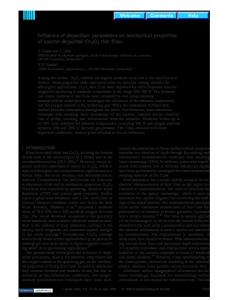Strain induced super-paramagnetism in Cr 2 O 3 in the ultra thin film limit
- PDF / 830,393 Bytes
- 5 Pages / 612 x 792 pts (letter) Page_size
- 20 Downloads / 351 Views
Strain induced super-paramagnetism in Cr2O3 in the ultra thin film limit Iori Tanabe1, Haseeb Kazi2, Yuan Cao2, Jack L Rodenburg1, Takashi Komesu1, Bin Dong2, Frank L Pasquale2, M. Sky Driver2, Jeffry A Kelber2, and Peter A Dowben1 1
Department of Physics and Astronomy, Theodore Jorgensen Hall, 855 North 16th Street, University of Nebraska, PO Box 880299, Lincoln, NE 68588-0299, U.S.A. 2 Department of Chemistry, University of North Texas, 1155 Union Circle, #305070, Denton, TX 76203-5017, U.S.A. ABSTRACT Ultra thin films of chromia (Cr2O3), less than 3 nm thick, grown epitaxial on -Al2O3 (sapphire), and are thus compressively strained in-plane. The resulting films show evidence of some magnetic ordering above the Néel temperature of chromia (307 K). The observed higher temperature hysteresis effect observed are very likely a strain effect, and not associated with the typical antiferromagnetic ordering expected of chromia. INTRODUCTION There has been a long standing interest in chromia (Cr2O3), leading to a very rich literature of the interface properties of this material. Because of the similarities in structure, the growth of chromia (Cr2O3) thin films on sapphire or Al2O3(0001) is very popular [1-12]. While epitaxial growth is evident for thin chromia films [12], there is, in fact, a lattice mismatch between chromia and -Al2O3 (sapphire): with a=4.758 Å and c=12.991 Å for -Al2O3 and a=4.9575 Å and c=13.594 Å for -Cr2O3 [13] at room temperature. EXPERIMENT Chromia on Al2O3(0001) (sapphire) was grown by magnetron sputter deposition in the introduction chamber (base pressure 1×10-7 Torr) with a (Ar+O2) gas mixture, with a relative Ar:O2 pressure ratio of 1:9 at 500 K. Commercially available Al2O3 (0001) was used as the substrate. Subsequent annealing at 850 K in UHV produced an ordered Cr2O3 film on alumina, as described elsewhere [12]. The double layer Cr2O3(0001)/Al2O3(0001) samples with different thickness, 13 Å and 25 Å were investigated by means of both longitudinal and polar magneto-optical Kerr effect (MOKE) measurement setup at temperatures T 290 K, 330 K and 390 K. An intensity stabilized helium-neon laser beam of wavelength 632.8 nm and an output power of >1.0 mV was used. The light was then further polarized and the reflected beam periodically modulated by the photoelastic modulator with a frequency of 50 kHz, also used as a modulation reference signal for lock-in amplifier to provide phase sensitive detection for the signal from a photo-diode measuring the reflected beam off the sample. RESULTS
The quality of the Cr2O3 was established by low-energy electron diffraction (LEED), and x-ray photoelectron spectroscopy (XPS). As we noted, sapphire is the frequent substrate of choice [1-12] for chromia growth because of the close lattice match to α-Al2O3(0001) substrate. This is borne out in our LEED studies as well. The LEED image for the chromia/alumina film (Figure 1 (b)) exhibits C3V symmetry, indicating that the film grown on alumina occurs in a single domain film, or at least twinning of the chromia
Data Loading...











